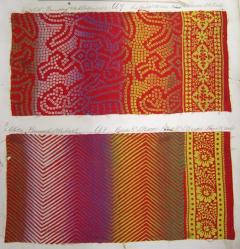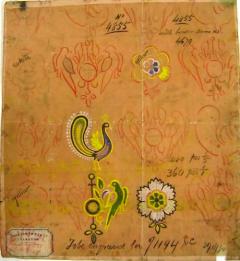Colouring the Nation
This three-year research project, directed by Dr Stana Nenadic of the University of Edinburgh in collaboration with Dr David Caldwell of the National Museum of Scotland and with Dr Sally Tuckett as Post-doctoral Researcher, investigates the cultural and global impact of the Scottish textile industry since the nineteenth century.

Funded by the Royal Society of Edinburgh and the Scottish Government (Royal Society of Edinburgh Major Research Grants in the Arts and Humanities) the three-year project, which started in April 2011, investigates the design and manufacturing processes that lay behind the production of decorative textiles in Scotland and will establish the global reach of these fabrics.
The popular perception of Scotland’s industrial past is dominated by images of the heavy industries of coal mining and ship building. By focusing on the textile industries, many of which were colourful, fashionable and exported across the globe, this perception will be redressed.
The collaborative nature of the project, combining documentary research with analysis of surviving artefacts, means that many different facets of the Scottish textile industry will be explored including the history of design and the history of science in culture. The themes discussed and analysed throughout the project will act as a foundation for future projects based on the Scottish textile industry.
Turkey Red Dyeing and Printing
A particular focus of the project is Turkey red dyeing and textile printing, which dominated the Vale of Leven in Dunbartonshire, sustaining major businesses and providing extensive employment in the area through to the mid-twentieth century. Turkey red was a method of dyeing which came from the east - hence the name - and was resistant to both sunlight and washing, producing a bright, fast colour. This colour was used to produce bright red, plain cotton cloths as well as elaborately decorated printed textiles which were sent to destinations as far afield as India, the West Indies, Africa and North America.

Research on this aspect of the Scottish textile industry is based on nearly 200 pattern books (comprising textile samples and paper designs, many protected by patent) which survive from the nineteenth and twentieth centuries and are housed in the collections of the National Museum of Scotland.
These pattern books are being used to produce an annotated catalogue, outlining the history of the manufacturing firms involved and placing the textile designs in a wider social, economic and cultural context. The pattern books are being used to create a free-to-access online exhibition hosted by the NMS which will showcase the bright and colourful designs of the various firms involved in the industry.
The exhibition will show the different categories of patterns produced and will capture a representative overview of the different markets for which Turkey red printed fabrics were destined, providing a valuable research tool for those interested in Scottish design and industrial heritage. Academic publications and outreach workshops are being developed in conjunction with this project.
[Fabrics produced by John Orr Ewing & Co., Alexandria and Glasgow. Images courtesy of National Museums Scotland.]

